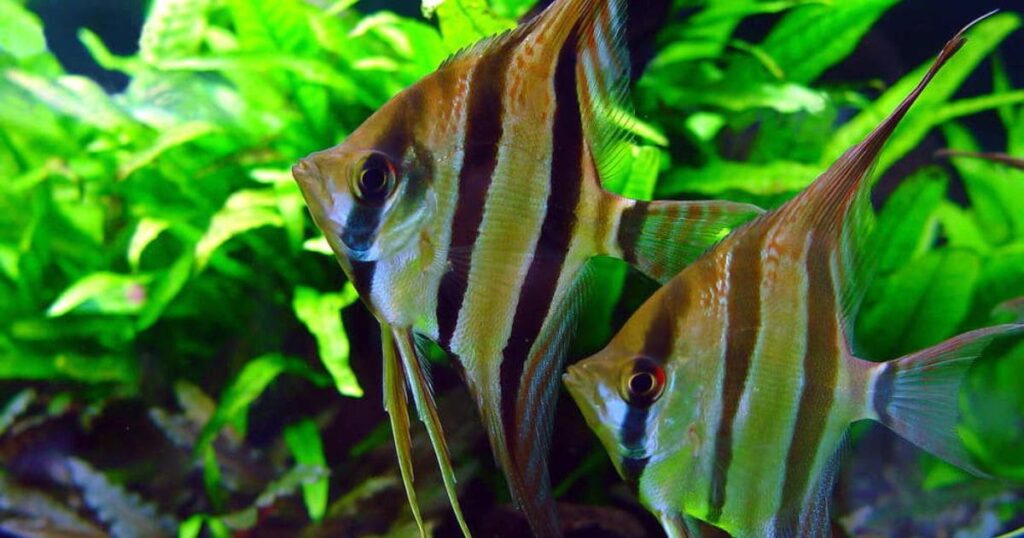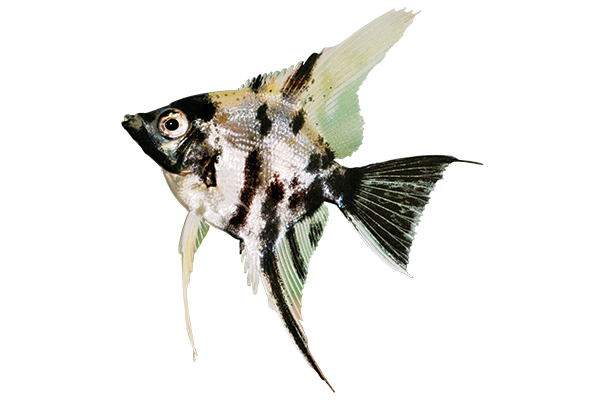As an Amazon Associate, I earn from qualifying purchases
Angelfish should be fed once or twice a day, in small portions that they can consume within 5 minutes. Overfeeding can lead to health problems and water quality issues.
Due to their striking appearance and calm demeanor, angelfish are popular aquarium fish. Keeping them healthy and happy requires a balanced diet and a proper feeding schedule. We’ll discuss how often angel fish should be fed and what to feed them.
We’ll also cover some common feeding mistakes to avoid to ensure your angel fish thrive in their aquatic environment. So, let’s dive in and learn more about feeding these beautiful fish.

The Importance Of Proper Feeding
The Importance of Proper Feeding:
Ensuring your angel fish are fed correctly is crucial for their health and well-being.
Essential Nutritional Needs
For angelfish to thrive, they need a balanced diet, including high-quality flakes, pellets, and occasionally live or frozen foods.
Impact On Health And Behavior
Proper feeding directly influences the health and behavior of angel fish, promoting vibrant colors and active swimming.

Understanding Angel Fish Feeding Habits
Angelfish should be fed 2-3 times a day, with small portions to prevent overfeeding. Maintaining a consistent feeding schedule and monitoring their appetite is essential to their health. Their health depends on maintaining a consistent feeding schedule and monitoring their appetite.
Understanding Angel Fish Feeding Habits Natural Feeding Behavior In their natural habitat, angel fish are omnivorous and feed on a varied diet of small crustaceans, insects, and algae. They are known to be opportunistic feeders, meaning they will consume food whenever it is available. Their feeding habits are influenced by the availability of food sources in their environment, and they are accustomed to grazing throughout the day.
Adaptation to Captive Feeding When kept in captivity, angel fish quickly adapt to a regular feeding schedule. Mimicking their natural feeding habits by providing small and frequent meals is essential. Maintaining their health and preventing overeating, can lead to digestive problems. In a captive environment, angel fish thrive on a diet that includes high-quality flake or pellet food, supplemented with live or frozen foods such as brine shrimp, bloodworms, and daphnia.
A balance must be struck between feeding them enough to meet their nutritional needs and preventing overfeeding, which can negatively impact water quality. When feeding angel fish, observe their behavior to determine the appropriate frequency. Maintaining their health and ensuring adequate nutrition requires feeding them small amounts repeatedly throughout the day.
In summary, understanding the natural feeding behavior of angel fish and their adaptation to captive feeding is crucial in determining how often they should be fed. By replicating their natural grazing habits and providing a varied diet, you can ensure the well-being of these beautiful and graceful fish in your aquarium.
Key Factors Influencing Feeding Frequency
Keeping angel fish healthy and thriving requires frequent feeding. Several key factors influence how often you should feed your angel fish, including their age, size, water temperature, and quality.
Age And Size Of The Angel Fish
The age and size of your angel fish play a significant role in determining their feeding frequency. Younger and smaller angel fish generally have higher metabolisms and require more frequent feeding to support their growth and energy needs. As they mature and grow, their feeding frequency can be adjusted accordingly.
Water Temperature And Quality
The water temperature and quality in your aquarium also impact the feeding frequency of your angel fish. Warmer water temperatures can increase the metabolic rate of the fish, leading to a higher need for food. Additionally, maintaining optimal water quality is essential for the health of your angel fish and can influence their appetite and feeding behavior.
Determining The Right Feeding Schedule
Observation Of Fish Behavior
Monitor angel fish activity after feeding to gauge hunger levels.
Check for signs of overfeeding or underfeeding based on fish behavior.
Trial And Adjustment
Start with small feedings and observe the fish response.
Gradually increase or decrease feeding frequency based on fish behavior.
Types Of Food For Angel Fish
Angelfish are beautiful and popular freshwater aquarium fish known for their graceful movements and vibrant colors. To ensure their health and well-being, it’s essential to provide a balanced diet that meets their nutritional needs. Understanding the types of food suitable for angel fish is crucial for maintaining their optimal health.
Live Foods
Live foods are an excellent option for feeding angel fish as they mimic their natural diet in the wild. These include brine shrimp, bloodworms, daphnia, and mosquito larvae. Besides providing essential nutrients, live food encourages fish’s natural hunting behavior, stimulating their minds and bodies.
Commercially Prepared Foods
Commercially prepared foods, such as flakes, pellets, and freeze-dried options, are convenient and can provide a well-rounded diet for angel fish. Look for high-quality products specifically formulated for angel fish, ensuring they contain proteins, carbohydrates, and vitamins to support their overall health.
Common Feeding Mistakes To Avoid
When it comes to feeding angel fish, the key is moderation. Overfeeding can lead to health issues. Feed angel fish in small amounts two to three times a day for optimal health. Keep your angel fish healthy by avoiding common feeding mistakes
Overfeeding
Overfeeding angel fish can lead to health issues and poor water quality. Stick to a feeding schedule to prevent overfeeding.
Underestimating Dietary Variety
Ensure a balanced diet by offering a variety of foods such as flakes, pellets, and live or frozen options. Lack of variety can lead to nutritional deficiencies.
Special Considerations For Breeding
Breeding angel fish requires special attention to their nutritional needs and feeding habits. To ensure successful breeding, enhanced nutritional needs, and proper fry feeding are crucial aspects to consider
Enhanced Nutritional Needs
During the breeding process, angel fish have higher nutritional requirements. Health and reproduction depend on a balanced diet rich in proteins and vitamins.
Feeding Fry
It’s important to feed fry small, frequent meals so they can grow and develop. Live or frozen food options can be beneficial for young angel fish.
- Offer a variety of foods such as brine shrimp and microworms to ensure proper nutrition.
- Monitor the fry closely to adjust feeding schedules as they grow.
| Food Type | Feeding Frequency |
|---|---|
| Brine Shrimp | 2-3 times daily |
| Micro Worms | Once daily |
By meeting the specific dietary needs of breeding angel fish and providing adequate nutrition for their fry, you can enhance the health and success of your breeding endeavors.
Adjusting Feeding Frequency
Summer Feeding
In the summer, angelfish tend to be more active and their metabolism increases, requiring more frequent feeding. To prevent overfeeding and contamination of the water, feed them 2-3 times a day in small portions. Ensure to monitor their appetite and adjust the feeding frequency accordingly.
Winter Feeding
Because of the low temperatures during winter, angel fish are less active, so their metabolism slows down. Reducing the feeding frequency to once a day or even every other day is advisable. To prevent uneaten food from polluting the tank, adjust the portion size.
Monitoring And Adapting The Feeding Regimen
Monitoring the feeding regimen of angel fish is crucial to determining how often they should be fed. You can feed them small amounts several times a day, depending on their behavior and appetite. This helps maintain their health and prevents overfeeding.
Keeping your angel fish healthy and happy requires more than just feeding them regularly. Their eating regimen needs to be adjusted based on their feeding habits.
Signs Of Over Or Underfeeding
Overfeeding your angel fish can lead to health problems such as bloating, constipation, and even death. Underfeeding, on the other hand, can result in malnutrition and stunted growth. It’s important to monitor your fish for signs of over or underfeeding. Signs of overfeeding include uneaten food, bloated bellies, and excess waste in the tank.
Fine-tuning The Schedule
The frequency and amount of food you give your angel fish depends on their age, size, and activity level. Adult angel fish should be fed once or twice a day, while juveniles should be fed three to four times a day. To fine-tune the feeding schedule, observe your fish’s behavior. Being overly active or constantly begging for food may indicate a need for more food. It’s also important to vary the types of food you’re giving your fish.
A diet that consists solely of flakes can lead to malnutrition. Supplement their diet with live or frozen food such as brine shrimp, bloodworms, or krill. In conclusion, monitoring and adapting your angel fish’s feeding regimen is key to keeping them healthy and happy. Observe their behavior and adjust their feeding schedule and diet to ensure they live long and thrive.
Consulting With Aquatic Experts
Due to their stunning appearance and unique behavior, angelfish are popular species among aquarium enthusiasts. A healthy diet and the right amount of food are crucial to their well-being. Aquatic experts can provide tailored advice for your specific tank setup and fish when it comes to how often to feed angel fish. Here are some ways to seek professional advice:
Seeking Professional Advice
When you care for your angel fish, seeking guidance from professionals in the aquatic field can be incredibly beneficial. These experts possess a wealth of knowledge and experience that can help you maintain a healthy environment for your fish. Here are some ways to connect with aquatic experts:
Online Communities And Forums
Online communities and forums dedicated to aquariums and fishkeeping are great resources for seeking advice from experienced hobbyists and professionals. These platforms offer the opportunity to ask questions, share experiences, and learn from others in the community. Some popular online communities and forums include:
- Reddit’s r/aquariums
- Aquarium Advice Forum
- Fishlore Forum
By participating in these online communities and forums, you can connect with individuals who have firsthand experience with angel fish and can offer valuable insights on feeding frequency and quantity.
Frequently Asked Questions
How Often Should I Feed My Angelfish?
Feed your angelfish 2-3 times daily, providing small amounts each time. They thrive on a varied diet, including flake, pellets, and live or frozen foods. Remove uneaten food to maintain water quality. Keep a consistent feeding schedule to ensure their well-being.
How Long Can Angelfish Live Without Food?
Angelfish can survive up to two weeks without food. However, it is not recommended to leave them unfed for this long, as it can lead to health issues. Regular feeding is crucial for their well-being.
How Do I Tell If My Angelfish Is Happy?
You can tell if your angelfish is happy by observing its behavior. A happy angelfish will swim actively, have vibrant colors, and eat well. It will also interact with its tankmates and show curiosity about its environment. Creating a comfortable and stimulating environment will help keep your angelfish happy.
Conclusion
Feeding your angel fish is crucial. Remember, moderation is key to their health. By following a consistent feeding schedule, you can maintain a thriving aquarium. Keep in mind their dietary needs and adjust accordingly. A happy, well-fed angel fish will bring you joy for years.
As an Amazon Associate, I earn from qualifying purchases

